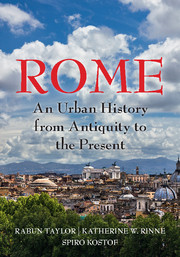Book contents
- Frontmatter
- Dedication
- Epigraph
- Contents
- List of Illustrations
- Acknowledgments
- Map
- INTRODUCTION
- 1 A BEND IN THE RIVER
- 2 A STORYBOOK BEGINNING
- 3 IDEOLOGICAL CROSSFIRE
- 4 BIG MEN ON THE CAMPUS
- 5 RES PUBLICA RESTITUTA
- 6 MEMORIALS IN MOTION: SPECTACLE IN THE CITY
- 7 THE CONCRETE STYLE
- 8 REMAKING ROME'S PUBLIC CORE: I
- 9 REMAKING ROME'S PUBLIC CORE: II
- 10 CRISIS AND CONTINUITY
- 11 RUS IN URBE: A GARDEN CITY
- 12 ADMINISTRATION, INFRASTRUCTURE, AND DISPOSAL OF THE DEAD
- 13 MAPPING, ZONING, AND SEQUESTRATION
- 14 TETRARCHIC AND CONSTANTINIAN ROME
- 15 TROPHIES AND TITULI: CHRISTIAN INFRASTRUCTURE BEFORE CONSTANTINE
- 16 WALLS MAKE CHRISTIANS: FROM FOURTH TO FIFTH CENTURY
- 17 A TALE OF TWO ROMES
- 18 THE ROME OF GOTHS AND BYZANTINES
- 19 CHRISTIAN FOUNDATIONS
- 20 FROM DOMUS LATERANI TO ROMANUM PALATIUM
- 21 THE LEONINE CITY: ST. PETER'S AND THE BORGO
- 22 VIA PAPALIS, THE CHRISTIAN DECUMANUS
- 23 THE URBAN THEATERS OF IMPERIUM AND SPQR
- 24 HOUSING DAILY LIFE
- 25 CHAOS IN THE FORTIFIED CITY
- 26 THE TIBER RIVER
- 27 HUMANIST ROME, ABSOLUTIST ROME (1420–1527)
- 28 PLANNING COUNTER REFORMATION ROME
- 29 PROCESSIONS AND POPULATIONS
- 30 MAGNIFICENT PALACES AND RHETORICAL CHURCHES
- 31 NEOCLASSICAL ROME
- 32 PICTURING ROME
- 33 REVOLUTION AND RISORGIMENTO
- 34 ITALIAN NATIONALISM AND ROMANITÀ
- 35 A CITY TURNED INSIDE OUT
- Glossary of Persons, Places, and Terms
- Works Cited
- Index
22 - VIA PAPALIS, THE CHRISTIAN DECUMANUS
Published online by Cambridge University Press: 05 July 2016
- Frontmatter
- Dedication
- Epigraph
- Contents
- List of Illustrations
- Acknowledgments
- Map
- INTRODUCTION
- 1 A BEND IN THE RIVER
- 2 A STORYBOOK BEGINNING
- 3 IDEOLOGICAL CROSSFIRE
- 4 BIG MEN ON THE CAMPUS
- 5 RES PUBLICA RESTITUTA
- 6 MEMORIALS IN MOTION: SPECTACLE IN THE CITY
- 7 THE CONCRETE STYLE
- 8 REMAKING ROME'S PUBLIC CORE: I
- 9 REMAKING ROME'S PUBLIC CORE: II
- 10 CRISIS AND CONTINUITY
- 11 RUS IN URBE: A GARDEN CITY
- 12 ADMINISTRATION, INFRASTRUCTURE, AND DISPOSAL OF THE DEAD
- 13 MAPPING, ZONING, AND SEQUESTRATION
- 14 TETRARCHIC AND CONSTANTINIAN ROME
- 15 TROPHIES AND TITULI: CHRISTIAN INFRASTRUCTURE BEFORE CONSTANTINE
- 16 WALLS MAKE CHRISTIANS: FROM FOURTH TO FIFTH CENTURY
- 17 A TALE OF TWO ROMES
- 18 THE ROME OF GOTHS AND BYZANTINES
- 19 CHRISTIAN FOUNDATIONS
- 20 FROM DOMUS LATERANI TO ROMANUM PALATIUM
- 21 THE LEONINE CITY: ST. PETER'S AND THE BORGO
- 22 VIA PAPALIS, THE CHRISTIAN DECUMANUS
- 23 THE URBAN THEATERS OF IMPERIUM AND SPQR
- 24 HOUSING DAILY LIFE
- 25 CHAOS IN THE FORTIFIED CITY
- 26 THE TIBER RIVER
- 27 HUMANIST ROME, ABSOLUTIST ROME (1420–1527)
- 28 PLANNING COUNTER REFORMATION ROME
- 29 PROCESSIONS AND POPULATIONS
- 30 MAGNIFICENT PALACES AND RHETORICAL CHURCHES
- 31 NEOCLASSICAL ROME
- 32 PICTURING ROME
- 33 REVOLUTION AND RISORGIMENTO
- 34 ITALIAN NATIONALISM AND ROMANITÀ
- 35 A CITY TURNED INSIDE OUT
- Glossary of Persons, Places, and Terms
- Works Cited
- Index
Summary
AS THE CROW FLIES, ABOUT FIVE KILOMETERS SEPARATE THE VATICAN AND the Lateran – a long walk and a considerable distance on horseback. The spiritual energy flowing between them created an unlikely Christian decumanus, a major east–west street that now rivaled the ancient north–south cardo defined by Via Flaminia/Appia. To the medieval Roman and the foreign pilgrim this was the ultimate ceremonial path, Christian Rome's triumphal way. It conjured images of dazzling processions led by pontiffs and crowned heads of state, eventfully traversing the city with meaningful stops and attendant ritual. Processions such as the papal possesso, a ritual walk to the Lateran taken by the newly crowned pope, began at St. Peter's (Fig. 135). From there one moved down the length of the porticoed Via Cornelia toward the Tiber with the somber bulk of Hadrian's Mausoleum as the first beacon; across Pons Aelius, and through the Campus Martius, with pagan landmarks and Christian stations to the right and left, to the foot of the Capitoline; then skirting it along the north and east to enter the Roman Forum; passing through it to the crest of the Velia at the southeast end, where the Arch of Titus stood and opened the way down the slope to the Colosseum; and up again, to the top of the Caelian and the sprawling and spirited complex of the Lateran.
This was Via Lateranensis, Via Papalis, Via Maior: as close to an organizing central axis as medieval Rome ever had. But it was no triumphal route in the formal sense. Were it not for the power of processions to fashion continuity and cohesiveness through ceremonial movement, it would be seen for what it really was, a string of neighborhoods and a patchwork of streets of different width and indifferent rectitude, going uphill and down, and flanked by everything from rows of unassuming houses or yard walls to the still-proud marble frames of ancient theaters, monumental monasteries, and parish churches. It was no cardo or decumanus in the Roman sense. Via Papalis was not, in other words, the initial organizing determinant of the course of urban order, but the unanticipated and improvised reaction to the pull of two far-flung ceremonial centers.
- Type
- Chapter
- Information
- RomeAn Urban History from Antiquity to the Present, pp. 205 - 213Publisher: Cambridge University PressPrint publication year: 2016



